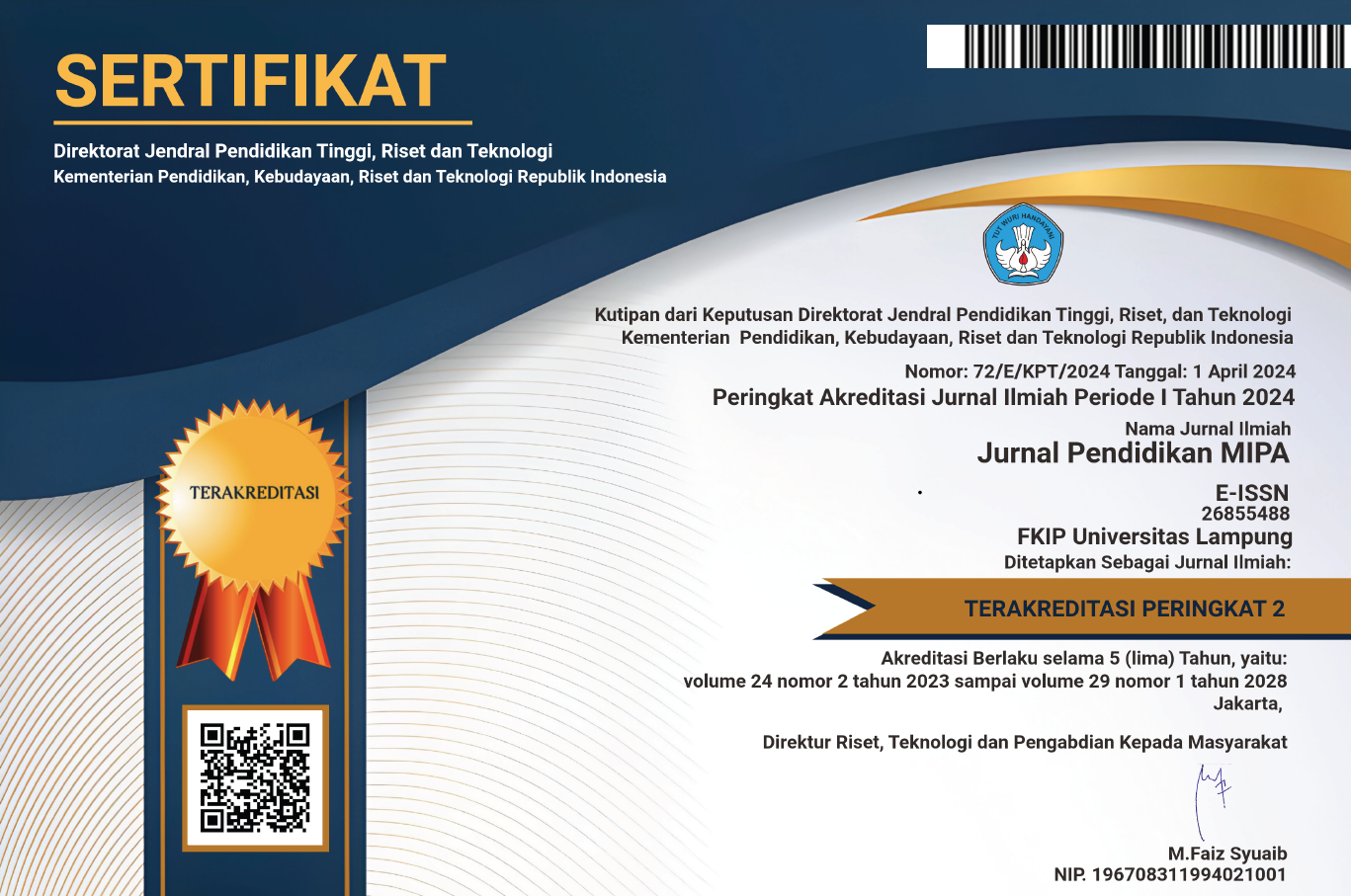Development of a Multiplication Learning Media for Primary School Mathematics using Multiple Math Card
 Country:
Country:
(1) Universitas Muhammadiyah Jakarta, Indonesia
(2) Universitas Muhammadiyah Jakarta, Indonesia
This study aims to develop MATHCA (Multiple Math Card) learning media in multiplication material of elementary school grade III. The background of this research is that there are no learning media in the form of cards that have been developed specifically by combining a learning system with a game in the form of cards. The method used in the Research and Development (R&D) uses the method Analysis, Design, Development, Implementation, Evaluation (ADDIE) model. The subjects in the study were third-grade students of SD Negeri 1 Cisantana, Cigugur district, Kuningan Regency. The result showed that media MATHCA was very valid base on the calculation result of media experts, with an average score of 98%, material experts with an average score of 92%, and linguists with an average score of 92%. The result of the practicality test of teachers obtained an average score of 90%, and the results of trials conducted in small groups obtained 96,6%, and in large group, trials obtained a score of 91,1%, this indicates a high level of practicality category in both groups. Thus, it can be concluded that MATHCA learning media that was developed using the ADDIE model is valid and practical to be applied to mathematics learning.
Keywords: development model, learning media, ADDIE, multiple math card.
Akbar, S. (2013). Instrumen perangkat pembelajaran [Learning device instruments]. Bandung: Remaja Rosdakarya.
Astriani, L., & Iswan. (2020). Pengaruh pembelajaran terpadu model tersarang (nested) terhadap keliling dan luas bangun datar [The effect of nested model integrated learning on perimeter and area of flat shapes]. Jurnal Perseda: Jurnal Pendidikan Guru Sekolah Dasar, 3(2), 63–68.
Chen, T., & Cai, J. (2019). An elementary mathematics teacher learning to teach using problem posing: A case of the distributive property of multiplication over addition. International Journal of Educational Research, 1–11.
Duengo, S., Latjompoh, M., & Ibrahim, M. (2020). Validitas perangkat pembelajaran berorientasi model pembelajaran “Smart” pada materi sistem pencernaan manusia untuk melatih kemampuan berpikir siswa SMP [The validity of the "Smart" learning model oriented learning tool on the human digestive system material to train the thinking ability of middle school students]. Jambura Edu Biosfer Journal, 2(2), 65–72.
Gita Lestari, D., & Hani Irawati. (2020). Literature review: Peningkatan hasil belajar kognitif dan motivasi siswa pada materi biologi melalui model pembelajaran guided inquiry [Interactive multimedia-based learning media to enhance students’ concepts understanding]. BIOMA: Jurnal Biologi dan Pembelajarannya, 2(2), 51–59.
Hamid, M. A., Yuliawati, L., & Aribowo, D. (2020). Feasibility of electromechanical basic work e-module as a new learning media for 17 vocational students. Journal of Education and Learning (EduLearn), 14(2), 199–211.
Handayani, J. A., Al-Bahij, A., & Bahar, H. (2020). Analisis kesiapan pembelajaran daring peserta didik kelas I Sekolah Dasar Negeri Ciputat 04 di masa pandemi Covid-19 [Analysis of online learning readiness of class I students at Ciputat 04 State Elementary School during the Covid-19 pandemic]. Nasional Penelitian LPPM, 1–5.
Iswan., Ismah., Astriani, L., & Mimah. (2022). Utilization of e-learning media for the independence learning of elementary school students. Frontiers in Education Technology, 5(2), 1–17.
Kementerian Koordinator Bidang Pembangunan Manusia dan Kebudayaan. (2021). Pendidikan berperan penting dalam menyongsong Smart Society 5.0 [Education plays an important role in welcoming Smart Society 5.0].
Kristanto, V. H. (2018). Metodologi penelitian: Pedoman penulisan karya tulis ilmiah [Research methodology: Guidelines for writing scientific papers]. Deepublish: CV Budi Utama.
Kurnia, I., Noviantiningtyas, T., & Nur Rohmania, Q. (2021). Game Hago sebagai media pembelajaran di sekolah dasar [Game Hago as a learning media in elementary school]. Jurnal Pendidikan Dasar Nusantara, 7(1), 119–129.
Majid, E. (2020). Pengembangan e-modul android berbasis metakognisi sebagai media pembelajaran biologi peserta didik kelas XII di tingkat SMA/MA [Development of metacognition-based Android e-module as a medium of biological learning of class XII learners at high school / MA level] (Doctoral dissertation, UIN Raden Intan Lampung).
Maksum, A. (2012). Metodologi penelitian dalam olahraga. Surabaya: Unesa University Press.
Marisa, U., Yulianti, & Arief, R. H. (2020). Pengembangan e-modul berbasis karakter peduli lingkungan di masa pandemi Covid-19 [Development of character-based e-modules caring for the environment during the Covid-19 pandemic]. Unikama PGSD National Seminar, 4(1).
Markovits, Z. (2011). Beliefs held by pre-school prospective teachers toward mathematics and its teaching. Procedia - Social and Behavioral Sciences, 11, 117–121.
Riduwan. (2015). Skala pengukuran variabel-variabel penelitian [Measurement scale of research variables]. Bandung: Alfabeta.
Saleh, S., Saleh, F., Rahman, S. A., & Mohamed, A. R. (2010). Diagnosing year two pupils’ misunderstanding of multiplication concepts at selected schools in Sabah. Procedia - Social and Behavioral Sciences, 8, 114–120.
Saputro, B. (2011). Manajemen penelitian pengembangan [Management of research and development]. Yogyakarta: Aswaja Presindo.
Sidarta, K. T., & Yunianta, T. N. H. (2019). Pengembangan kartu Domano (Domino Matematika Trigono) sebagai media pembelajaran pada matakuliah trigonometri [Development of Domano card (Domino Mathematics Trigono) as learning media in trigonometry course]. Scholaria: Jurnal Pendidikan dan Kebudayaan, 9(1), 62–75.
Smith, S. Z., & Smith, M. E. (2010). Assessing elementary understanding of multiplication concepts. School Science and Mathematics, 106(3), 140–149.
Sugiyono. (2015). Metode penelitian pendidikan [Educational research methods]. Bandung: Alfabeta.
Thahir, A., Anwar, C., Saregar, A., Choiriah, L., Susanti, F., & Pricilia, A. (2020). The effectiveness of STEM learning: Scientific attitudes and students’ conceptual understanding. Journal of Physics: Conference Series, 1467(1), 012008.
Wagiran. (2013). Metodologi penelitian pendidikan (Teori dan implementasi) [Educational research methodology (Theory and implementation)]. Deepublish: CV Budi Utama.
Winarni, E. W. (2018). Teori dan praktek penelitian kuantitatif, kualitatif, PTK, dan R&D [Theory and practice of quantitative, qualitative research, classroom action research, and R&D]. Jakarta: Bumi Aksara.
Yuniasih, N., Putri, R. E. N., Nita, R., & Findawati, Y. (2019). DOMI KALI: Elementary school multiplication learning media. Journal of Physics: Conference Series, 1402, 077084.
Refbacks
- There are currently no refbacks.

This work is licensed under a Creative Commons Attribution-ShareAlike 4.0 International License.






